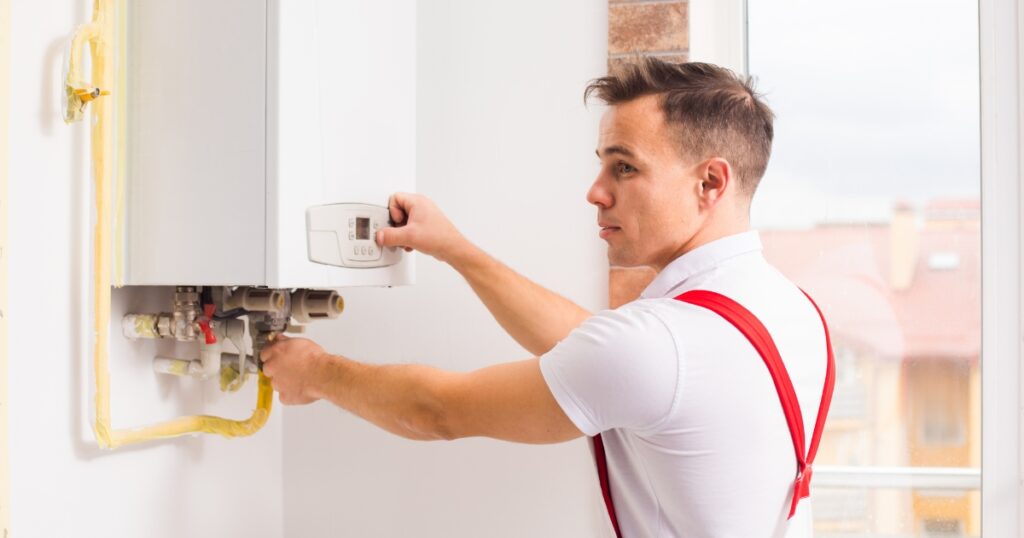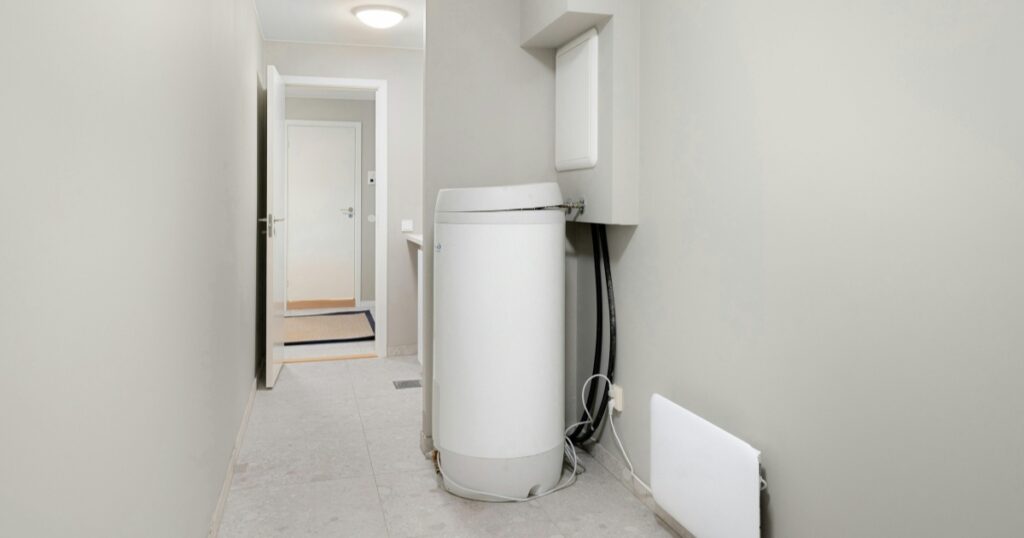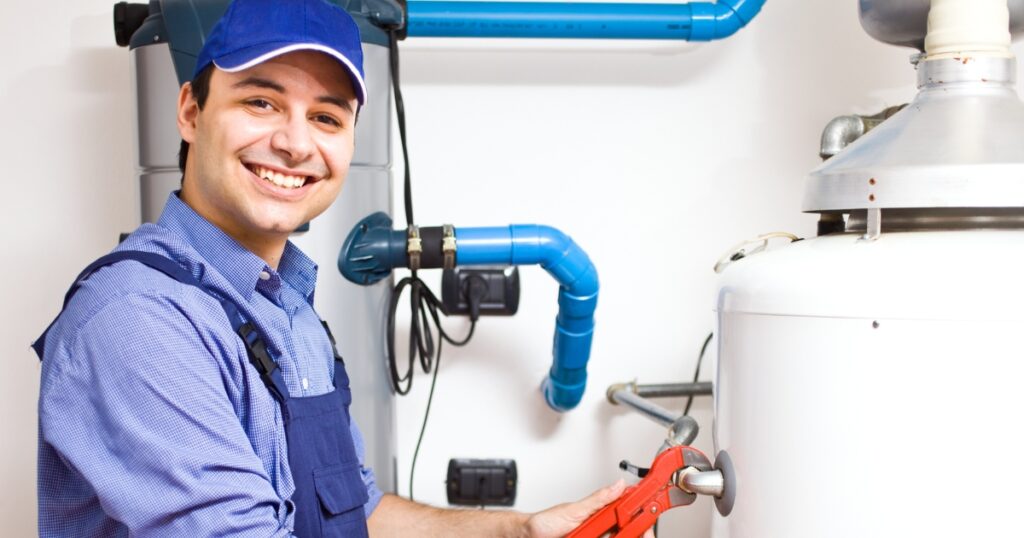Strewth, there’s nothing quite as shocking as copping an icy blast when you’re all lathered up for a warm rinse, hey? It’s a common whinge amongst us Aussies with gas hot water heaters.
So I’ve done the hard yakka of diving into the nitty-gritty of hot water systems to sort out this guide for you. By the time we’re done, you’ll be sorted with top tips to combat those dodgy temperature dips and keep your showers snug as a bug.
So hang tight—your days of unpredictable showers are about to be given the flick!
Key Takeaways
- Diagnosing hot water heater temperature fluctuations involves checking thermostat settings, inspecting the heating element, testing for sediment buildup, and ensuring the pressure balancing valve is working properly.
- Common problems with hot water heaters include water temperature issues, discoloured or smelly water, unusual noises, leaks, and damaged gas control or burner assembly.
- Regular maintenance and timely repairs are crucial in addressing these issues to maintain a consistent and reliable supply of hot water.
Common Hot Water Heater Problems
Water temperature issues can be caused by thermostat malfunctions or sediment buildup in the tank. Discoloured/Smelly water, noises, leaks and damaged gas control or burner assembly are also common problems that may occur with hot water heaters.

Water temperature issues
Dealing with water temperature issues in our hot water heaters can be quite a hassle. We’ve all been there, stepping into a steamy shower only to get blasted by cold water—or worse, scalded when it’s unexpectedly too hot.
More often than not, this is down to a faulty thermostat or sediment build-up affecting the heating element. It’s crucial we check these parts for proper functioning to keep our showers comfortable and safe.
If you have a gas hot water system that’s acting up, don’t panic just yet; first, inspect your gas control or burner assembly as they could be the culprits behind inconsistent temperatures.
For electric heater owners, hitting the reset button might just do the trick if your system isn’t heating up at all. Regular checks are key – tankless units need their temperature settings monitored closely since they provide instant heat without storage space for hot water reserves.
Let’s tackle these challenges head-on and restore our systems back to prime condition without delay!
Discoloured/Smelly water
After addressing water temperature issues, discoloured or smelly water is another common problem that homeowners may encounter with their hot water heaters. Rusty or murky water and a foul odour could indicate sediment buildup, corrosion inside the tank, or bacterial growth in the water heater.
Identifying the cause of discoloured or smelly water involves checking for sediment accumulation at the bottom of the tank and inspecting for signs of rust. Flushing the tank can help clear out any sediments and eliminate unpleasant smells, while regular maintenance and periodic flushing can prevent these issues from occurring.
If the problem persists despite efforts to clean it out, professional plumbing services may be needed to address underlying problems such as corrosion or bacterial contamination.
Noises
When dealing with hot water heater issues, it’s essential to address unusual noises as they can be a sign of potential problems. Rumbling or banging sounds in gas hot water systems may indicate sediment buildup at the bottom of the tank, compromising efficiency and causing fluctuating temperatures.
Even minor clicking or tapping noises should not be ignored, as they could point to electrical component malfunctions in both electric and gas water heaters.
Inspecting and addressing these noises promptly will help prevent more significant issues from arising. Regular maintenance and professional attention to persistent or concerning sounds are crucial in maintaining your hot water system’s functionality.
Leaks
Leaks in your hot water heater can lead to water damage and increased energy bills. Check for any signs of moisture around the tank or pooling water beneath it. Addressing leaks promptly is crucial to prevent further damage to your home and ensure the efficient operation of your hot water system.
Regularly inspecting and maintaining your hot water heater can help identify and fix leaks before they worsen, potentially saving you time, money, and inconvenience in the long run.
If you notice leaks from your hot water heater, contact a professional plumbing service to assess the situation and perform necessary repairs. Ignoring leaks could result in more severe problems down the line, so acting quickly is essential to keep your hot water system functioning properly.
Damaged gas control or burner assembly
If you’ve ruled out leaks as the cause of your hot water heater problems, it’s time to take a closer look at the gas control or burner assembly. These components play a crucial role in heating the water and maintaining the desired temperature.
Over time, they can become damaged or malfunction, leading to issues such as inconsistent water temperature or no hot water at all. It’s important to address these problems promptly to ensure that your hot water system continues to function efficiently.
When dealing with damaged gas control or burner assembly, homeowners should seek professional service for repair. Testing and repairing these components require technical expertise and specialised tools.
Diagnosing the Issue
We’ll check the thermostat settings, inspect the heating element, test for sediment buildup, and ensure that the pressure-balancing valve is working properly to diagnose the issue.
These steps will help us pinpoint the problem with your hot water heater and determine if it’s something you can fix yourself or if you need professional service.
Check thermostat settings
First, locate the thermostat on your hot water heater. Use a screwdriver to adjust the temperature setting and ensure it is set between 120-140 degrees Fahrenheit. Double-check that both thermostats (upper and lower) are set at the same level if you have a dual-element system.
Look out for any corrosion or damage while inspecting the thermostats, as this could also cause temperature fluctuations.
Next, test the thermostat by turning it up or down slightly and listen for a click within 5 minutes; this indicates that it’s working properly. If there’s no click, consider replacing the thermostat according to manufacturer guidelines.
Once done, check the accuracy of your water heater’s temperature using a thermometer at a faucet farthest from your unit to confirm the desired results.
Inspect heating element
When diagnosing water temperature fluctuations, inspecting the heating element is crucial. Over time, sediment buildup or corrosion can affect its performance, leading to inconsistent water temperatures.
By visually checking the heating element for signs of damage and using a multimeter to test its electrical continuity, you can determine if it needs to be replaced.
An accurate assessment of the heating element’s condition will help in addressing temperature control issues effectively. It is essential to follow manufacturer guidelines for safe inspection and replacement processes when dealing with electric hot water systems.
Check for sediment buildup
Inspecting the heating element can reveal sediment buildup, which may be causing temperature fluctuations in your hot water system. Over time, mineral deposits can accumulate at the bottom of the tank, insulating the water from the heating source and affecting its efficiency.
Sediment buildup can also lead to overheating and premature wear on the tank components, ultimately resulting in temperature irregularities. Regularly checking for and flushing out sediment buildup is essential to maintain a consistent and reliable supply of hot water.
Sediment accumulation often causes a loss of capacity within a hot water heater’s tank, reducing its ability to deliver an adequate supply of hot water when needed. To prevent this issue, it is important to periodically flush out any sediment that has settled at the bottom of your hot water heater’s tank using proper methods as suggested by professionals or manufacturers.
Test pressure balancing valve
After addressing potential issues with sediment buildup, it’s important to test the pressure balancing valve. Fluctuating water temperature can often be attributed to a faulty or malfunctioning pressure balancing valve in your hot water system.
This crucial component is responsible for regulating the mix of hot and cold water to ensure a consistent temperature output at your taps. Testing this valve involves checking for any blockages, corrosion, or wear that may be impacting its functionality.
Professional hot water repairs are essential when dealing with issues related to the pressure balancing valve, as their expertise will ensure thorough diagnosis and effective repair solutions.
Check the hot water tank size
After ensuring the pressure balancing valve is working correctly, it’s crucial to check your hot water tank size. A smaller tank may struggle to meet your household’s demand for hot water, leading to temperature fluctuations and inadequate heating.
Upgrading to a larger capacity tank can alleviate these issues and provide a more consistent supply of hot water, especially during peak usage times.
If you’re experiencing frequent changes in water temperature and are consistently running out of hot water, it may be time to consider upgrading your hot water tank size. This simple adjustment can make a significant difference in improving the efficiency and functionality of your home’s hot water system.

How to Troubleshoot and Repair an Electric Water Heater
- Check and replace thermostats if necessary
- Inspect and replace heating elements as needed
- Address any pilot light or gas valve issues that may be causing problems
- Don’t forget to flush the tank regularly for optimal performance!
Checking and replacing thermostats
To ensure your hot water heater is functioning optimally, you can start by checking and if necessary, replacing the thermostats. This will help regulate the temperature of the water effectively. Here are the steps to follow:
- Turn off the power supply to the water heater at the circuit breaker.
- Use a screwdriver to remove the access panel or cover from the thermostat.
- Use a multimeter to test for continuity on each thermostat terminal. If there is no continuity, it indicates a faulty thermostat and it needs to be replaced.
- If both thermostats are functioning correctly, you may need to adjust their settings according to your desired water temperature.
Inspecting and replacing heating elements
After checking and replacing thermostats, the next step is to inspect and replace the heating elements. Here’s how you can do it:
- Turn off the power supply to the water heater at the circuit breaker.
- Use a multimeter to test the heating elements for continuity. If there is no continuity, replace them with new ones.
- Ensure that the replacement elements match the voltage and wattage rating of your current water heater.
- Carefully install the new heating elements, ensuring they are securely fitted and all connections are tightened.
- Once installed, turn on the power supply and monitor the water heater for proper functioning.
Addressing pilot light and gas valve issues
If you’re experiencing issues with your hot water heater pilot light or gas valve, you can address these problems by following these steps:
- Check the pilot light to see if it is lit. If it’s out, follow the manufacturer’s instructions for relighting it.
- Inspect the gas valve to ensure it is fully open and not obstructed.
- Test the gas valve by turning it off and then back on to see if there’s any improvement in the water temperature.
- Look for any signs of damage or corrosion on the gas valve and immediately contact a professional if any issues are found.
- Ensure that the area around the pilot light and gas valve is free from debris and dust.
Flushing the tank
After addressing pilot light and gas valve issues, the next step to troubleshoot and repair an electric water heater is flushing the tank. This process helps to remove sediment buildup and improve the heater’s efficiency. Here’s how you can do it:
- Turn off the power supply to the water heater at the circuit breaker.
- Shut off the cold water supply valve to the water heater.
- Connect a garden hose to the drain valve at the bottom of the tank.
- Place the other end of the hose in a suitable drainage area, such as a floor drain or outside.
- Open a hot water tap in your home to allow air into the tank while draining.
- Open the drain valve and let the tank completely empty.
- Close the drain valve and disconnect the hose once empty.
- Turn on the cold water supply valve and fill up the tank partially before repeating steps 3 – 7 until clear water runs from the hose.
Get Your Hot Water Heater Diagnosed
In conclusion, diagnosing and fixing temperature fluctuations in your hot water heater is achievable with the right guidance. Understanding common problems and conducting regular maintenance can help prevent issues before they escalate.
Whether you opt for a DIY approach or seek professional service, addressing water heater problems promptly is key to ensuring a steady supply of hot water in your home. Regular troubleshooting and maintenance can extend the lifespan of your hot water system, saving you time and money in the long run.






